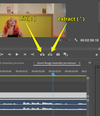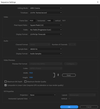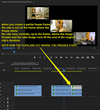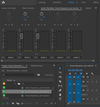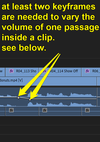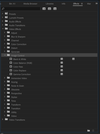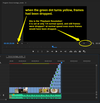ARCHIVE - ORIGINAL DECK Flashcards
On 04.03.21 I duplicated the persent deck of 181 cards into three decks of more or less 60 cards, to make study easier. So, if as a learner you find these decks, the ones named 1 to 3 should be the ones to go for, unless you think you can handle a deck of 181 cards?...
In editing mode, what are the shortcut keys to move between screens?
Project Panel - Shift 1
Source Monitor - Shift 2
Timeline - Shift 3
Program Monitor - Shift 4
new project dialog:
How to avoid loss of data in the event of disk failure?
‘Project Auto Save’:
by default is set to ‘Same as Project’, but in case of disk crash of your laptop, having your live project saved to an external disk will preserve your work.
the folders that hold clips in the media browser are called…?
bins
import a clip into the Source Monitor from the Project Panel - how?
either drag or x2click the clip
What is the key-based Timeline navigation system called?
(backward, stop, forward)
JKL
- *J** is backward
- *K** is pause
- *L** is forward
the names of the four screens in Pr, clockwise, from bottom, left:
- PROJECT PANEL
- SOURCE MONITOR
- PROGRAM MONITOR
- TIMELINE

How do you import a folder and its contents (yes, including subfolders) into the media browser?
x2-click the empty space and navigate to the folder and click ‘Import Folder’
beautiful shortcut key to expand a selected panel:
the backtick key
- it’s below the Escape key!

What does it mean to ‘mark a clip’
It simply means selecting a segment of it that you want to use, leaving out the before and after.
Adding an In and an Out is what you’re doing.
to get to the point where to insert an In or an Out point, you can ‘scrub’ the playhead to get there. You can, of course, use the JKL keys as well.
Not happy with an In or Out point? No sweat: move to where you want the new In/Out and hit the command again - the existing mark is replaced with the new one.
in the ‘Timeline’ panel, what’s the keyboard shortcut to display your stuff full-width?
the \ key
NOTE: if you hit the \ key again, it will revert to the previous view.
In the Project panel, the various items are prefixed with colour-coded squares -
What is the default colour for sequence?
GREEN
What’s the difference between transcoding and creating proxies?
Transcoding is the generic term for re-encoding any video into a video with different settings. Proxies, are the lower quality files you reference while editing, but if you set up correctly in Premiere, it knows to give you the proxy files while editing.
In the Project panel, what’s the difference between duplicating and copying files?
Duplicate files have the suffix ‘copy1’ added to them;
Copies look exactly the same as originals - and can thus be a source of confusion.
NOTE: files in the Project panels are mere shortcuts, and deleting them does not affect the actual files, which reside somewhere else, on your computer or external hard disk.
What should you do - EVERY TIME - with your sequence at the end of a work session?
You should duplicate it.
You should also add the date of that edit to its name.
If you mess up your sequence in your next work session, you can always go back to your previous version!
JKL tricks
How to:
- play in slow motion
- play one frame at a time
- play at increased speeds
- Hold down K, then hold down J/L
- Hold down K, then tap J/L
- very handy for navigating audio
- double-tapping J/L plays at double the speed
- further, single, taps increase speed even more.
In/Out creation
How to keep your original In/Out when creating a new one?
- in Assembly Mode…
- You have an In/Out already in Program Monitor
- and so you go: Menu//Make Subclip (Ctrl+U)
- dialog - name your subclip
subclips are either unrestricted or restricted
- meaning that you can either drag to recover some or all the footage on either end of the clip or you don’t.
NOTE: restricted clips, both video and audio, on the Timeline, sport tiny white triangles at their top corners.
Sequence settings -
how to change them?
- right-click the sequence in Project Panel
- select ‘Sequence Settings’
- tweak settings in dialog
REMEMBER: the first clip you import in the Timeline: its properties will be applied to the entire sequence.
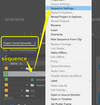
Sequence -
defining the settings even before you start populating the Timeline:
- right-click in an empty space in the Project Panel
- New Item / Sequence
- ‘New Sequence’ dialog pops up

Moving a clip from the Source Monitor to the Timeline - what is the keyboard shortcut?
comma
What is the keyboard shortcut to play a segment between an In and an Out?
(applies to both the Source Monitor and the Timeline)
Ctrl+Shift+Spacebar
make the playhead snap to either end of a clip in the timeline
Shift + drag playhead
You can also use the Up and Down arrows
(in my case, my Down arrow is out of order…)
Dragging a clip from the Source Panel into the Timeline and in-between two clips on the timeline -
what needs to be done to avoid overwriting anything already on the Timeline?
Ctrl + drag
Hovering your cursor over a video’s thumbnail causes it to play.
That action is called…
hoverscrub
How do you display project settings?
- go in ‘Assembly’ mode
(top menu in Pr) - in Media Browser menu bar, click ‘Ingest’
- the ‘Project Settings’ dialog pops up
NOTE
Under the ‘Ingest’ dropdown you can select ‘General’, Scratch Disks as well as ‘Ingest Settings’.



